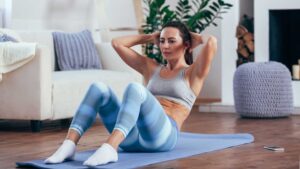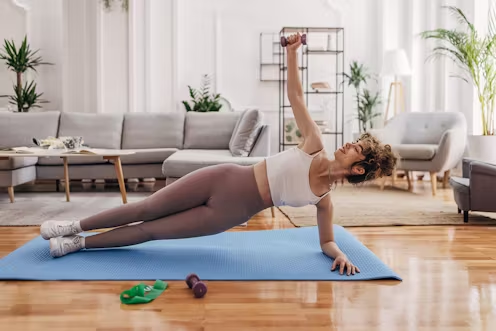In recent years, the trend of home workouts has skyrocketed, and for good reason. The convenience, cost-effectiveness, and versatility of exercising at home make it an attractive option for many. Whether you’re a seasoned fitness enthusiast or a beginner looking to start your journey, home workouts offer a flexible and effective way to stay in shape. This comprehensive guide will explore the benefits, types of exercises, equipment options, and tips for creating an effective home workout routine, helping you achieve your fitness goals without ever stepping foot in a gym.
The Benefits of Home Workouts
- Convenience and Flexibility
One of the most significant advantages of home workouts is the convenience they offer. There’s no need to commute to a gym, adhere to specific class schedules, or wait for equipment to become available. You can exercise at any time that suits you, making it easier to fit workouts into a busy schedule. Whether you’re a morning person or prefer working out in the evening, home workouts can accommodate your lifestyle.
- Cost-Effectiveness
Gym memberships and fitness classes can be expensive, especially when factoring in additional costs like transportation and special equipment. In contrast, home workouts require minimal investment. With just a few basic pieces of equipment or even bodyweight exercises, you can achieve a full-body workout. This cost-effectiveness makes home workouts accessible to everyone, regardless of budget.
- Privacy and Comfort
For many, the gym environment can be intimidating, especially when starting a new fitness regimen. Exercising at home provides a private and comfortable space where you can work out without feeling self-conscious. This privacy can be particularly beneficial for beginners who may feel unsure about using certain equipment or performing exercises in public.
- Customization and Personalization
Home workouts allow for complete customization of your fitness routine. You can choose exercises that cater to your specific goals, preferences, and fitness level. Whether you’re aiming to build muscle, lose weight, improve flexibility, or enhance cardiovascular health, you can tailor your workouts accordingly. Additionally, the absence of gym distractions means you can focus entirely on your exercises, leading to more efficient workouts.
- Time Efficiency
In a gym, time can be lost waiting for machines, navigating through crowds, or commuting. Home workouts eliminate these time-wasters, allowing you to complete your workout more efficiently. With well-structured routines, you can achieve a high-quality workout in as little as 30 minutes, making it easier to fit into a busy day.
Essential Components of an Effective Home Workout Routine
To create a balanced and effective home workout routine, it’s essential to incorporate various types of exercises that target different aspects of fitness. Here are the key components to consider:
- Cardiovascular Exercises
Cardiovascular exercises, or cardio, are essential for improving heart health, burning calories, and boosting endurance. They get your heart rate up and increase circulation, benefiting overall health. Some effective home cardio exercises include:
Jumping Jacks: A simple, full-body exercise that raises your heart rate quickly.
Burpees: A high-intensity exercise that combines a squat, plank, and jump, targeting multiple muscle groups.
High Knees: Running in place while lifting your knees as high as possible, engaging your core and leg muscles.
Mountain Climbers: A dynamic plank variation that works your core, legs, and cardiovascular system.
Dancing: An enjoyable way to get your heart pumping, whether through a structured dance workout or simply moving to your favorite music.
- Strength Training
Strength training helps build muscle, improve metabolism, and increase bone density. It’s crucial for overall fitness and can be done effectively at home using bodyweight exercises or basic equipment like dumbbells and resistance bands. Key strength training exercises include:
Push-Ups: Targeting the chest, shoulders, triceps, and core, push-ups are a versatile upper-body exercise.
Squats: Excellent for strengthening the legs and glutes, squats can be modified for all fitness levels.
Lunges: Another great lower-body exercise that also engages the core and improves balance.
Planks: An isometric exercise that works the entire core, as well as the shoulders and back.
Dumbbell Rows: Using dumbbells or household items like water bottles, this exercise targets the upper back and biceps.
- Flexibility and Mobility
Flexibility and mobility exercises are crucial for maintaining joint health, preventing injuries, and improving overall movement quality. Incorporate stretching and mobility work into your routine to enhance flexibility. Some effective exercises include:
Dynamic Stretches: Such as leg swings or arm circles, which prepare the body for movement.
Static Stretches: Holding a stretch for a prolonged period to increase flexibility. Focus on major muscle groups like hamstrings, quadriceps, and shoulders.
Yoga Poses: Poses like Downward Dog, Child’s Pose, and Cat-Cow help improve flexibility and promote relaxation.
Foam Rolling: A form of self-myofascial release that can help reduce muscle tightness and improve mobility.
- Core Workouts
A strong core is essential for overall strength, stability, and balance. Core workouts target the muscles around your abdomen, lower back, and pelvis. Key core exercises include:
Crunches: Targeting the upper abdominal muscles.
Leg Raises: Focusing on the lower abs.
Russian Twists: Engaging the obliques and improving rotational strength.
Bicycle Crunches: Combining abdominal and cardiovascular work.
Plank Variations: Including side planks and plank jacks, to engage the entire core.
Equipment Options for Home Workouts
While many effective home workouts can be performed using just your body weight, incorporating some equipment can add variety and intensity to your routine. Here are some essential and versatile pieces of equipment to consider:
- Resistance Bands
Resistance bands are affordable, portable, and versatile tools that can be used for strength training, stretching, and rehabilitation. They come in various resistance levels, making them suitable for all fitness levels.
- Dumbbells
Dumbbells are classic strength training tools that can be used for a wide range of exercises, from bicep curls to weighted squats. Adjustable dumbbells are a space-saving option that allows you to change weights easily.
- Kettlebells
Kettlebells are excellent for dynamic exercises that build strength, endurance, and coordination. Kettlebell swings, goblet squats, and Turkish get-ups are just a few examples of effective kettlebell exercises.
- Yoga Mat
A good-quality yoga mat provides a comfortable surface for floor exercises, stretching, and yoga. It also helps prevent slipping during workouts.
- Jump Rope
Jumping rope is an effective cardio exercise that improves coordination and burns calories. It’s a great addition to any home workout routine.
- Pull-Up Bar
A pull-up bar can be installed in a doorway and is ideal for upper body strength exercises like pull-ups, chin-ups, and hanging leg raises.
- Stability Ball
A stability ball, also known as a Swiss ball, can be used for core exercises, stretching, and stability training. It’s particularly useful for exercises like ball crunches and planks.
- Foam Roller
A foam roller is a great tool for self-myofascial release, helping to alleviate muscle tightness, improve mobility, and aid in recovery.
Creating an Effective Home Workout Routine
Designing an effective home workout routine involves setting clear goals, choosing appropriate exercises, and maintaining consistency. Here are some steps to help you create a personalized plan:
- Set Clear Goals
Define your fitness goals, whether they are related to weight loss, muscle building, cardiovascular health, flexibility, or overall wellness. Setting specific, measurable, achievable, relevant, and time-bound (SMART) goals can help you stay focused and motivated.
- Assess Your Fitness Level
Before starting a new workout routine, assess your current fitness level. This can help you choose exercises that are appropriate for your abilities and prevent injuries. If you’re a beginner, start with basic exercises and gradually increase intensity as you progress.
- Choose a Balanced Exercise Plan
Ensure your workout routine includes a mix of cardiovascular exercises, strength training, flexibility, and core workouts. A balanced plan will address all aspects of fitness and help you achieve well-rounded results.
- Plan Your Schedule
Decide how many days a week you will work out and how long each session will be. Consistency is key to seeing progress, so create a realistic schedule that you can stick to. Aim for at least 150 minutes of moderate-intensity aerobic activity or 75 minutes of vigorous-intensity aerobic activity per week, along with two or more days of strength training.
- Warm-Up and Cool Down
Always include a warm-up and cool-down in your workouts. A warm-up prepares your body for exercise by gradually increasing your heart rate and loosening your muscles. A cool-down helps your body recover and reduces the risk of injury. Both should last around 5-10 minutes and include light cardio and stretching.
- Track Your Progress
Keep a workout journal or use a fitness app to track your progress. Recording your workouts, including the exercises, sets, reps, and weights used, can help you monitor your improvements and stay motivated. It’s also a useful tool for adjusting your routine as needed.
- Stay Motivated
Staying motivated is crucial for maintaining a consistent workout routine. Find what inspires you, whether it’s setting new fitness goals, joining an online fitness community, or rewarding yourself for achieving milestones. Remember, consistency is key to seeing results, so stay committed to your routine.
Sample Home Workout Routines
Here are some sample home workout routines to help you get started. These routines can be adjusted based on your fitness level and equipment availability.
Beginner Full-Body Workout (30 Minutes)
Warm-Up (5 minutes)
Jumping jacks
Arm circles
Leg swings
Cardio (5 minutes)
High knees
Butt kicks
Strength Training (15 minutes)
Bodyweight squats: 3 sets of 15 reps
Push-ups (modified or standard): 3 sets of 10 reps
Plank: 3 sets of 30 seconds
Glute bridges: 3 sets of 15 reps
Dumbbell rows (using water bottles if no dumbbells): 3 sets of 12 reps per arm
Cool Down (5 minutes)
Standing hamstring stretch
Shoulder stretch
Cat-Cow stretch
Intermediate Upper Body Workout (45 Minutes)
Warm-Up (5 minutes)
Jump rope
Arm swings
Strength Training (30 minutes)
Push-ups: 4 sets of 12 reps
Dumbbell bench press: 4 sets of 12 reps
Dumbbell shoulder press: 4 sets of 10 reps
Pull-ups (using a pull-up bar or assisted): 4 sets of 8 reps
Dumbbell bicep curls: 4 sets of 12 reps
Triceps dips (using a chair): 4 sets of 12 reps
Core (5 minutes)
Plank: 3 sets of 1 minute
Russian twists: 3 sets of 20 reps
Cool Down (5 minutes)
Child’s Pose
Triceps stretch
Chest stretches
Advanced Lower Body Workout (60 Minutes)
Warm-Up (10 minutes)
Dynamic stretches (leg swings, hip circles)
Jumping jacks
Strength Training (40 minutes)
Squats (with or without weights): 4 sets of 15 reps
Lunges (alternating legs): 4 sets of 12 reps per leg
Deadlifts (using dumbbells or kettlebells): 4 sets of 12 reps
Bulgarian split squats: 4 sets of 10 reps per leg
Calf raises: 4 sets of 15 reps
Glute bridges (with resistance band): 4 sets of 15 reps
Core (5 minutes)
Bicycle crunches: 3 sets of 20 reps
Leg raises: 3 sets of 15 reps
Cool Down (5 minutes)
Standing quad stretch
Seated hamstring stretches
Pigeon pose
Overcoming Challenges in Home Workouts
While home workouts offer numerous benefits, they can also present challenges, such as staying motivated, limited space, and lack of equipment. Here are some tips to help you overcome these obstacles:
- Create a Dedicated Workout Space
Having a designated area for exercise can help you get into the right mindset and reduce distractions. Even if you have limited space, a corner of a room can serve as your workout zone. Keep your equipment organized and easily accessible.
- Use What You Have
If you don’t have traditional gym equipment, get creative with household items. For example, use water bottles as weights, a chair for tricep dips, or a towel for resistance band exercises. Bodyweight exercises are also highly effective and require no equipment.
- Follow Online Workouts
There are countless online resources, including videos, apps, and blogs, that offer guided workouts. Following a structured program can provide variety, keep you motivated, and ensure you’re performing exercises correctly.
- Set a Routine
Establishing a consistent workout schedule can help you stay disciplined and make exercise a regular part of your day. Treat your workout time as a non-negotiable appointment with yourself.
- Stay Accountable
Share your fitness goals with a friend or family member, or join an online fitness community. Having a support system can keep you accountable and motivated. You might even consider virtual workout buddies to exercise together over video calls.
- Listen to Your Body
While it’s important to challenge yourself, it’s equally crucial to listen to your body and avoid pushing too hard, especially if you’re new to exercise. Rest and recovery are essential components of any fitness routine.
Conclusion
Home workouts are a versatile, cost-effective, and convenient way to achieve your fitness goals. With the right approach, you can create a well-rounded and effective workout routine that fits your lifestyle and preferences. Whether you’re looking to build strength, improve cardiovascular health, or increase flexibility, home workouts offer endless possibilities. Remember to set clear goals, stay consistent, and enjoy the journey to better health and fitness.
In a world where time, cost, and convenience are major factors, home workouts provide a flexible and efficient solution to staying fit and healthy. So, roll out your mat, grab your weights (or household substitutes), and get started on your fitness journey today.








Leave a Reply